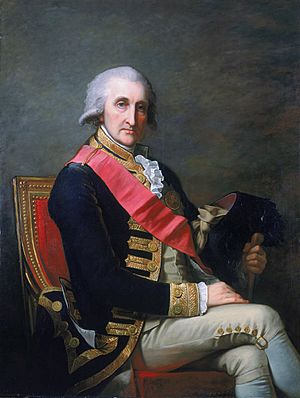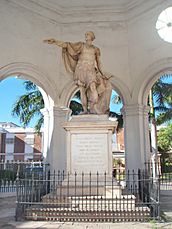George Brydges Rodney, 1st Baron Rodney facts for kids
Quick facts for kids
The Lord Rodney
|
|
|---|---|
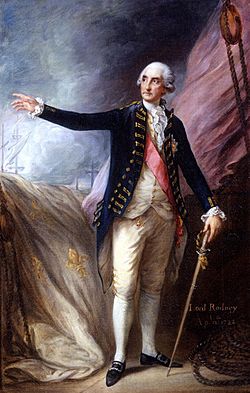
Admiral Rodney after the Battle of the Saintes, 1782, by Thomas Gainsborough. Behind is the French fleur de lys naval ensign from the captured Ville De Paris
|
|
| Born | bap. 13 February 1718 Walton-on-Thames, Surrey |
| Died | 24 May 1792 (aged 74) Hanover Square, London |
| Buried |
Old Alresford
|
| Allegiance | |
| Service/ |
|
| Years of service | 1732–1792 |
| Rank | Admiral |
| Commands held | Greenwich Hospital Jamaica Station Leeward Islands Station |
| Battles/wars |
|
| Awards | Knight of the Order of the Bath |
George Brydges Rodney, also known as Lord Rodney, was a famous British naval officer. He was born around 1718 and died in 1792. He is most famous for his leadership during the American War of Independence. His biggest victory was over the French navy at the Battle of the Saintes in 1782. Many people say he was the first commander to use a special tactic called "breaking the line" in naval battles.
Rodney came from a respected family, but they didn't have much money. He joined the navy when he was just fourteen years old. His first important battle was the Second Battle of Cape Finisterre in 1747. He earned a lot of "prize money" (money from capturing enemy ships) in the 1740s. This money helped him buy a large estate and become a member of the House of Commons of Great Britain.
During the Seven Years' War, Rodney took part in several attacks from the sea, like raids on Rochefort and Le Havre. He also helped capture Louisbourg and Martinique in 1762. After the war ended in 1763, Rodney faced money problems. He spent a lot trying to get ahead in politics. By 1774, he was deeply in debt and had to leave Britain to avoid people he owed money to. He was even in a French jail when war started again in 1778. Luckily, a French friend helped him get out. He returned to Britain and was given a new command.
Rodney successfully helped Gibraltar when it was under siege. He also defeated a Spanish fleet in the 1780 Battle of Cape St. Vincent, which was called the "Moonlight Battle" because it happened at night. He then went to the Jamaica Station. There, he was involved in the controversial capture of Sint Eustatius in 1781. Later that year, he went home because he was sick. While he was away, the British lost the important Battle of the Chesapeake, which led to the surrender at Yorktown.
Some people didn't like Rodney because they thought he cared too much about prize money. This became a big issue after he captured Saint Eustatius. He was heavily criticized in Britain for it. Orders were sent to call him back to Britain. But before they reached him, Rodney won a huge victory at the Battle of the Saintes in April 1782. This battle ended the French threat to Jamaica. Rodney later returned to Britain, where he was made a peer (a noble) and given a yearly payment. He lived a quiet life until he died in 1792.
Contents
George Brydges Rodney was probably born in January 1718. He was baptized on February 13, 1718. His family didn't have much money because his father lost a lot in a bad investment.
George went to Harrow School. At age 14, he joined the Royal Navy as a junior officer on Sunderland in 1732.
Early Career as a Captain
After serving on Sunderland, Rodney moved to Dreadnought from 1734 to 1737. His captain, Henry Medley, was a good teacher for him. Rodney quickly moved up the ranks, helped by his own skills and the support of the Duke of Chandos.
In 1739, he became a lieutenant on Dolphin. He then served on Namur, the main ship of Commander-in-Chief Sir Thomas Mathews.
Becoming a Captain
The War of the Austrian Succession had begun. In August 1742, Rodney had his first real action. He was ordered to attack Ventimiglia to destroy Spanish army supplies. He succeeded. Soon after, he became a post-captain on Plymouth. This made him one of the youngest captains in the navy.
He then protected British merchant ships in home waters. In 1745, he commanded Ludlow Castle and helped blockade the Scottish coast during the Jacobite Rebellion. Two of his young officers on Ludlow Castle were Samuel Hood and Rodney's younger brother, James. In 1746, he took command of the 60-gun Eagle. On May 24, he captured his first enemy ship, a Spanish privateer. Eagle then joined the Western Squadron.
Battle of Cape Finisterre

The Western Squadron was a new British naval plan. It aimed to block French ships more effectively by staying in the Western Approaches. This allowed them to guard both the English channel and the French Atlantic coast.
Eagle continued to capture enemy ships. Rodney's ship was not at the First Battle of Cape Finisterre, where the Western Squadron won a big victory. But later, Eagle joined a squadron that captured about 48 French merchant ships. Rodney even chased and captured six more ships that tried to escape.
On October 14, 1747, Eagle fought in the Second Battle of Cape Finisterre. This was another British victory off Ushant against the French fleet. The French had eight large warships, while the British had fourteen smaller ones. Rodney's ship, Eagle, fought the 70-gun Neptune for two hours. His ship became hard to control after a shot hit its steering wheel. The British captured six of the eight French ships.
These two battles showed that the Western Squadron strategy worked well. Rodney often spoke of the "good old discipline" of this squadron. After the war ended in 1748, Rodney's share of prize money was £15,000. This gave him financial security for the first time.
Becoming a Commodore
On May 9, 1749, Rodney was made governor and commander-in-chief of Newfoundland. He was given the rank of Commodore. At that time, a naval officer was usually chosen for this job because of the important fishing industry. Rodney commanded Rainbow and two smaller ships. He oversaw three summer trips to Newfoundland between 1749 and 1751.
Rodney also started to get involved in politics. He gained the support of powerful figures like the Duke of Bedford. In 1751, he was elected as a Member of Parliament for Saltash. After his last trip to Newfoundland, he bought an estate in Hampshire with his prize money.
In 1753, he married Jane Compton. They had three children before she died in 1757. Before the Seven Years' War began, Rodney commanded several ships in Portsmouth, but he didn't go to sea.
Seven Years' War Service
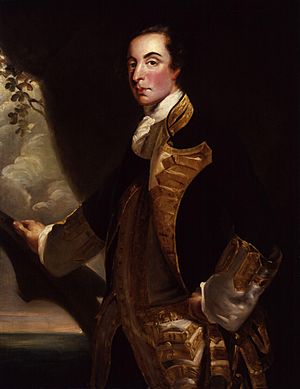
The Seven Years' War officially began in Europe in 1756. Rodney took part in naval patrols in 1755 and 1756.
Louisbourg Campaign
In 1757, Rodney commanded Dublin during an attack on Rochefort. The attack didn't achieve much. The next year, he served under Admiral Edward Boscawen in an effort to capture the French fortress of Louisbourg in North America. Rodney was tasked with carrying Major General Jeffery Amherst, the army commander, to Louisbourg. On the way, Rodney captured a French merchant ship. Some people criticized Rodney, saying he cared more about prize money than his mission. However, records show he sailed quickly after securing his prize.
Rodney's ship played a small part in the capture of Louisbourg. This victory opened the way for the British to move up the St Lawrence River and eventually capture Quebec. In August 1758, Rodney sailed home with six warships and ten transport ships carrying French prisoners of war.
Attacks on Le Havre
On May 19, 1759, Rodney became a rear admiral. He was given command of a small group of ships. The British learned that the French were gathering many flat-bottomed boats and supplies at Le Havre for a planned invasion of Britain. Rodney was ordered to attack Le Havre secretly.
On July 4, Rodney was off Le Havre. His force included six bomb-vessels that could fire shells high into the air. In what became known as the Raid on Le Havre, he bombarded the town for two days and nights. This caused great damage to French war materials. The bomb ships fired for 52 hours straight, starting large fires. Rodney then pulled back, leaving some ships to block the mouth of the Seine River. This attack boosted morale in Britain. Rodney tried another attack in August, but bad weather and better French defenses made it impossible. The French invasion was eventually canceled after their naval defeats at the Battle of Lagos and Battle of Quiberon Bay.
From 1759 to 1761, Rodney focused on blocking the French coast, especially around Le Havre. In July 1760, he captured many more French boats and blocked the coast near Dieppe.
Capturing Martinique
In 1761, Rodney was chosen to lead the naval part of a planned attack on the rich French colony of Martinique in the West Indies. He was promoted over many more senior officers. A previous British attack on Martinique had failed in 1759. In 1762, he was officially made commander-in-chief of the Leeward Islands Station.
Within the first three months of 1762, Rodney and General Robert Monckton captured the important island of Martinique. Saint Lucia and Grenada also surrendered to his ships. During the siege of Fort Royal, his sailors and marines helped greatly on land. Rodney's ships then joined the British expedition to Cuba. However, he was later criticized for moving his ships to protect Jamaica from a large Franco-Spanish force, instead of waiting to support the Cuba expedition as ordered.
After the Treaty of Paris in 1763, Admiral Rodney returned home. He had been made Vice-Admiral of the Blue and received thanks from Parliament. Martinique was returned to France in the peace treaty.
Years of Peace and Debt
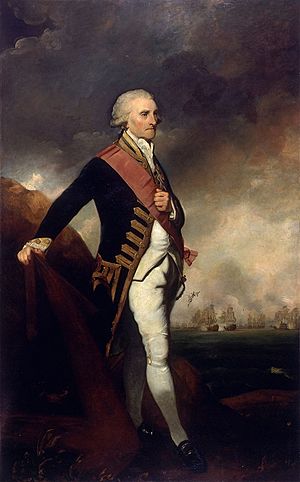
In 1764, Rodney was made a baronet (a type of knight). He also married Henrietta Clies. From 1765 to 1770, he was governor of Greenwich Hospital. He spent a lot of money on political campaigns. When he became Commander-in-Chief of the Jamaica Station in 1771, he lost his Greenwich job. But soon after, he became Rear-Admiral of Great Britain.
He commanded in Jamaica until 1774. During this quiet time, he improved the naval yards there. Rodney was disappointed not to become governor of Jamaica. His election spending and gambling losses ruined his finances. He couldn't even get his salary as Rear-Admiral of Great Britain. In 1778, he was promoted to Admiral of the White. He worked hard to get a command to solve his money problems. By May, a generous French friend, Marshal Biron, helped him pay off his debts. Rodney returned to London with his children. The money he was owed helped repay the debt.
American War of Independence Battles
In London, Rodney suggested to Lord George Germain that George Washington could be influenced by honors.
The Moonlight Battle
Rodney was again made commander-in-chief of the Leeward Islands Station in late 1779. He was ordered to help Gibraltar on his way to the West Indies. On January 8, 1780, he captured a Spanish convoy of 22 ships off Cape Finisterre. Eight days later, at the Battle of Cape St. Vincent, he defeated the Spanish Admiral Don Juan de Lángara. He captured or destroyed seven ships. This battle was known as the "Moonlight Battle" because it happened at night. He then brought supplies and reinforcements to Gibraltar.
Battle of Martinique
On April 17, 1780, he fought a battle off Martinique with the French Admiral Guichen. Due to some of Rodney's captains not following orders carefully, the battle ended without a clear winner.
Controversy at St Eustatius
After Britain declared war on the Dutch Republic, Rodney, following orders, captured the valuable Dutch island of St Eustatius on February 3, 1781. The island was a major trading hub. Rodney confiscated large amounts of goods, including those belonging to British merchants. This led to Rodney being involved in many expensive lawsuits for the rest of his life. However, the wealth he took from St. Eustatius was more than he expected.
Victory at the Saintes
After a few months in England to recover his health, Rodney returned to his command in February 1782. A smaller battle on April 9 led to his greatest victory at the Battle of the Saintes off Dominica. On April 12, with 35 ships, he defeated the Comte de Grasse, who had 33 ships. The French ships were larger and sailed better, but the British still captured four French ships (including the main French ship) and destroyed one after eleven hours of fighting.
This important battle saved Jamaica from French attack and greatly damaged French naval power. Rodney proudly wrote: "Within two little years I have taken two Spanish, one French and one Dutch admirals." There is a long debate about who first thought of the "breaking the line" tactic in this battle. A change in wind broke the French battle line, and the British ships took advantage by sailing through it in two places. Many French sailors, including the Comte de Grasse, were captured.
From April 29 to July 10, Rodney's fleet stayed at Port Royal, Jamaica for repairs after the battle.
Rodney's Recall
On April 15, Rodney wrote a letter celebrating his victory. The news of his win reached England on May 18, 1782. It greatly boosted national morale and strengthened those who wanted to continue the war. King George III noted that the victory had made the nation so excited that a peace treaty that would have been accepted earlier would now cause complaints.
Rodney was getting ready to sail to meet the enemy when HMS Jupiter arrived from England. It brought orders not only to relieve him of duty but also to bring his replacement, Admiral Hugh Pigot. This strange change happened because of changing politics in Britain. Rodney was a Tory, appointed by a Tory government. But the Whigs were now in power. Also, at 64 years old, he was perhaps due for retirement. The order to retire was sent on May 15, three days before the news of his victory at the Saintes reached the Admiralty. A faster ship sent later failed to catch the Jupiter, so Rodney's fate was sealed.
Rodney quietly left his ship, the Formidable, and returned to England on HMS Montagu.
Later Life and Legacy
Controversies
Rodney was a very skilled officer. However, he was also seen as vain and selfish. He was criticized for seeking prize money too much and for using his position to help his family. For example, he made his son a post-captain at age fifteen. These actions upset other officers and the Admiralty. Naval historian Nicholas A. M. Rodger said Rodney's weaknesses regarding favoritism "destroyed the basis of trust" needed for a commander. It's important to remember that he was also prematurely old and suffering from illness at this time.
Retirement and Death
Rodney arrived home in August 1782 and received great honors from his country. He had already been made Baron Rodney of Rodney Stoke, Somerset, on June 19, 1782. The House of Commons voted him a pension of £2000 a year. From then on, he lived a quiet country life until his death in London in 1792. His son, George, became the 2nd Baron.
In 1782, Rodney was given the Freedom of the City of Cork, Ireland. The National Maritime Museum in Greenwich, London, has the gold box they gave him.
Rodney died in 1792 and was buried in the church of St Mary the Virgin in Old Alresford, Hampshire. There is also a memorial to him in St Paul's Cathedral.
Legacy and Tributes
-
Monument of George Brydges Rodney in Memorial in Spanish Town
-
Rodney's Pillar on Breidden Hill in Wales
In February 1783, the government of Jamaica asked John Bacon, a famous British sculptor, to create a statue of Admiral Lord Rodney. This was to show their appreciation. The statue alone cost $5,200, and the whole project cost about $31,000. Bacon used the best marble from Italy to create the Neo-classical sculpture of the Admiral. It shows him dressed in a Roman robe. Cannons from the captured French flagship, Ville de Paris, were placed in front of the statue. This huge monument, known as the Rodney Temple, stands in Spanish Town, Jamaica, next to the Governor's House.
In late 1782 and early 1783, many taverns changed their names to "The Admiral Rodney" to honor his victory. Admiral Rodney's Pillar was built on Breidden Hill in Wales to remember his victories. In St. Paul's Cathedral crypt, there is a memorial to Rodney designed by Charles Rossi.
At least four warships of the Royal Navy have been named HMS Rodney in his honor. Two British public schools, Churcher's College and Emanuel School, have houses named after him.
Because he was popular with the people of Newfoundland as governor, small, round-bottomed wooden boats are still called a "Rodney" there today.
In 1793, after Rodney's death, the Scottish poet Robert Burns wrote a poem called "Lines On The Commemoration Of Rodney's Victory." It celebrates the Battle of the Saintes. The poem begins:
- "Instead of a Song, boy's, I'll give you a Toast;
- "Here's to the memory of those on the twelfth that we lost!-
- "That we lost, did I say?-nay, by Heav'n, that we found;
- "For their fame it will last while the world goes round. “
Places Named After Rodney
- Rodney Street, Liverpool
- Rodney Street, Edinburgh
- Rodney Bay, Saint Lucia, the Caribbean
- Rodney County, New Zealand
- Rodney Gardens, Perth, Scotland
- Cape Rodney, North Island, New Zealand
- Rodney, Ontario, Canada
- Admiral Rodney – Pub, Worcestershire
- Admiral Rodney - Pub, Criggion Lane, Powys
- Admiral Lord Rodney - Pub, Colne, Lancashire
- Admiral Rodney - Hotel, Horncastle, Lincolnshire
- Admiral Rodney - Pub, Sheffield
- Rodney Inn - Pub, Helston, Cornwall
- The Admiral Rodney Inn - Criggion, Powys (in sight of Rodney's Pillar monument on Breidden Hill)
- The Admiral Rodney Inn - Pub, Hartshorne, Swadlincote, Derbyshire.
- The Admiral Rodney - Pub, Prestbury, Cheshire
- The Lord Rodney - Pub, Keighley, West Yorkshire
- The Admiral Rodney - Pub, Calverton, Nottinghamshire
- The Rodney Hotel - Hotel, Clifton, Bristol
- Admiral Rodney - Pub, Wollaton, Nottinghamshire
Images for kids
See also
 In Spanish: George Brydges Rodney para niños
In Spanish: George Brydges Rodney para niños


